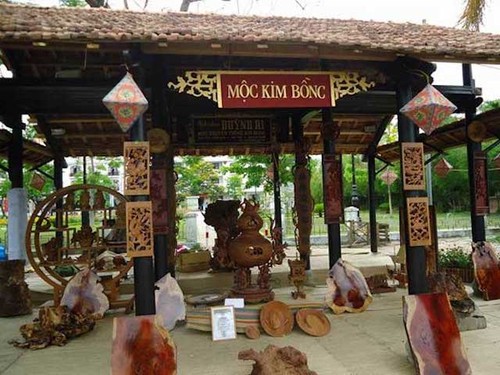 Ice appears in Sa Pa on December 22, 2023. (photo: VOV) Ice appears in Sa Pa on December 22, 2023. (photo: VOV) |
B: The winter in Vietnam’s northern region attracts many tourists from tropical countries. Noun Bopha of Siemreap, Cambodia, asked: “Where in Vietnam can I see snow? When should I come?”
A: Because snow doesn’t fall throughout the winter, someone who wants to experience that rare weather phenomenon in tropical Vietnam should follow the weather forecasts, wait patiently, and be prepared for an immediate departure when snow begins to fall. Some years the snow comes early, some years it comes late.
B: From December to January or early February, the temperature gradually decreases, and cold spells occur with more frequency. At this time of year, the temperature in Sapa can drop below 0 degrees Celsius triggering frost and snowfall. The snow may last from a few days to a week.
A: Sapa township in Lao Cai province is considered the most beautiful place to see snowfall in Vietnam. Snowflakes accumulate on roofs and pink peach branches, creating a poetic scene reminiscent of Europe.
 Ice on construction on Fansipan Mountain on December 25, 2023 (photo: VTCNews) Ice on construction on Fansipan Mountain on December 25, 2023 (photo: VTCNews) |
B: At an altitude of 3,100 meters above sea level, Fansipan mountain near Sapa has been dubbed “the Roof of Indochina”. Fansipan peak is beautiful capped with snow.
A: To reach Fansipan peak, you can take a cable car which reaches Do Quyen station in just 15 minutes. From the cable car, you can admire a broad mountain and forest panorama and watch a sea of clouds float over your head. If it’s snowing, you’ll get the rare extra treat of seeing snowflakes falling on the roofs, stairs, and trees below you.
B: Other places near Sa Pa that attract a lot of snow hunters are Thac Bac (Silver Waterfall), Ham Rong mountain, O Quy Ho pass, and Bat Xat commune.
A: Snow only blankets the mountains, forests, villages, and farms for a few days. It draws lots of tourists and boosts tourism services, but it can also cause hardship for the local people and harm their crops and livestock.
 Ice on O Quy Ho pass (photo: VOV) Ice on O Quy Ho pass (photo: VOV) |
B: After all, we recommend you get prepared for adventurous trips to Vietnam’s northern mountain region. With or without snow, the mountains will surprize you with spectacular, magnificent landscape. Next, Listener Saiteful Fahmi of Lombok, Indonesia, wrote: “Listening to your report last week on winter in Son La province, I wanted to know how long a harsh winter like that lasts? And do schools in Vietnam let students stay home?”
A: Some districts in Son La saw temperatures as low as 3 degrees Celsius last week. 140 schools allowed their students to stay home from school. It’s the same in other northern mountain provinces where many students live far from their school. Temperatures in the region have increased lately to between 10 and 20 degrees Celsius.
B: In Hanoi and other lowland provinces, nursery and primary school children are allowed to stay home when the temperature falls below 10 degrees. Older students still must go to school.
A: Every year charity organizations and caring individuals donate warm clothes and hot food to children in remote mountain areas and repair schools to make classrooms more comfortable during the cold days of winter.
B: The song “Nau An Cho Em” (Cooking for you) by rapper Den Vau was a music phenomenon last year. Den Vau donated all the proceeds (about 41,000 USD) to schools in Lai Chau and Cao Bang province and the Support Center for Students in HCMC.
A: The song talks about innocent but strong children enduring the long walk from home to school. The song inspired kind-hearted people to make donations to help thousands of school children. The song “Cooking for you” by rapper Den Vau won a Top 10 Songs of the Year of the Green Wave Award 2024.
"I’m very surprised. I believe all the other artists are also surprised to receive their awards. Thank you, audience, for listening and sharing to spread our songs. I wish all artists inspiration so we can continue to “cook” great songs for the audience. Thank you very much!" said Den Vau.
 The song "Cooking for you" by Rapper Den Vau helps over 1,000 children be adopted. The song "Cooking for you" by Rapper Den Vau helps over 1,000 children be adopted. |
B: Janet Rathner said she found our story about Kim Bong carpentry village in Hoi An very interesting. The story mentioned People’s Artisan Huynh Ri. Janet said she was thrilled to have purchased some of his works for her home.
A: Kim Bong carpentry village is in Cam Kim commune, Hoi An town beside the Thu Bon river. The 500-year-old village is renowned for its wood carving and sculpture. The village’s carpentry craft has been preserved by craftsmen like Huynh Ri, who has restored ancient temples and pagodas.
B: The Kim Bong carpentry tradition began in the late 15th century and flourished in the 18th century. Many local craftsmen contributed to building the architectural heritage of Hoi An town, which is famous for the delicate carvings of its ancient houses, pagodas, and club houses.
A: Huynh Ri’s products are frequently chosen as gifts for distinguished foreign visitors.
 Kim Bong Carpentry village (Photo: hoiancreativecity.vn) Kim Bong Carpentry village (Photo: hoiancreativecity.vn) |
B: Nigel Rennard asked about Ba Khia salted crab, one of the many specialties of Ca Mau province. He said: “My wife, who is Thai, is very interested in this specialty. Can I import Ba Khia salted crab into Thailand? There’s a local dish called "som tum", a papaya salad, that uses crab in its preparation. My wife would like to find a supplier who can bottle the crab and attach her food label before export. She is prepared to travel to Ca Mau province to put an export deal in place.”
A: Vietnamese and Thai food have a lot of similarities. We hope she can put together a successful business deal.
B: Making salted fermented crab has been going on for a long time in Ca Mau, Vietnam’s southernmost province. For generations, the basic steps for salting the crabs have remained unchanged. In the past, crab fishermen carried jars of salt water and whenever they caught a crab, they washed it and put it immediately into the jar. The next morning, the crabs were taken out, dried, and transferred to a new jar of salt water, which was tightly sealed until it was time to eat the crabs.
A: Today the crabs aren’t immediately salted after they’re caught. They’re left to become thirsty. Then, when they’re put in a jar of concentrated salt water, they drink the salt water and the salt water they drink preserves them longer and gives them a better flavor. Later, the jar is drained, the crabs are washed and then arranged in layers in the empty jar. Then new salt water is added.
B: Dinh Lu of Jiang Xu, China, wrote to say he received VOV’s QSL card. He was surprised and moved to see that the QSL card was hand-written, reflecting VOV’s personal touch when it comes to our listeners.
A: Thank you all, dear listeners, for tuning in to our channel and sending us feedback. We’ll send QSL cards to verify your reception reports. We hope to receive more correspondence from you.
B: We welcome your feedback at: English Service, VOVWorld, the Voice of Vietnam, 45 Ba Trieu street, Hanoi, Vietnam. Or you can email us at: englishsection@vov.vn. You’re invited to visit us online at vovworld.vn, where you can hear both live and recorded programs.